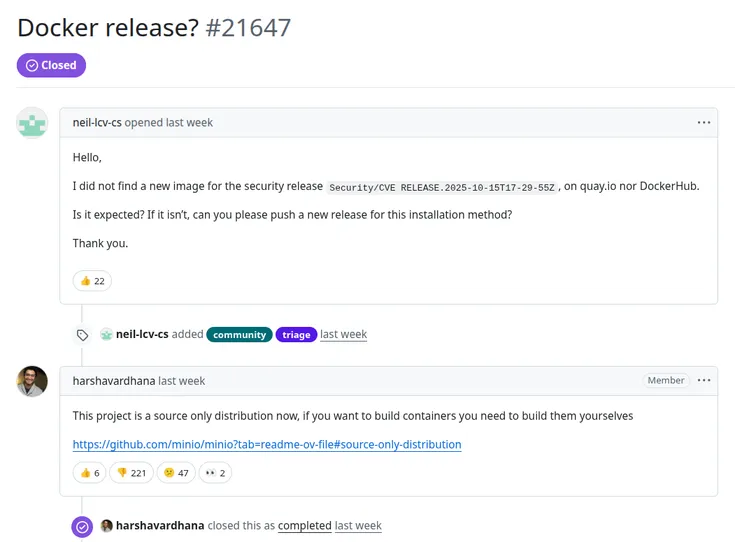
TL;DR
MinIO transitions to a source-only distribution model, ending pre-compiled Docker images, sparking community concerns over security and feature removal.
Key Points
Highlight key points with color coding based on sentiment (positive, neutral, negative).MinIO has transitioned to a source-only distribution model, meaning users must now build their own container images, as official images are no longer available on DockerHub or Quay.io.
This change has led to significant community backlash, with users expressing concerns over unannounced changes, potential security risks, and dissatisfaction with the removal of features and documentation.
The decision to stop distributing Docker images was planned and is not directly related to any specific security vulnerabilities, although the timing has been criticized.
Enterprise users have expressed frustration, feeling that the changes represent a lock-in strategy and have led to a loss of trust, especially since some features have been removed from the open-source version.
The removal of automatic update capabilities, such as those provided by services like watchtower, has raised concerns about the potential for running instances to remain vulnerable without regular updates.
Key Numbers
Present key numerics and statistics in a minimalist format.The maximum supported object size by MinIO.
The number of MinIO downloads on Docker Hub.
Stakeholder Relationships
An interactive diagram mapping entities directly or indirectly involved in this news. Drag nodes to rearrange them and see relationship details.Organizations
Key entities and stakeholders, categorized for clarity: people, organizations, tools, events, regulatory bodies, and industries.Responsible for the decision to shift MinIO to a source-only distribution model.
Tools
Key entities and stakeholders, categorized for clarity: people, organizations, tools, events, regulatory bodies, and industries.Previously hosted pre-compiled Docker images of MinIO, which are no longer available.
Another platform that hosted MinIO Docker images, affected by the distribution change.
Industries
Key entities and stakeholders, categorized for clarity: people, organizations, tools, events, regulatory bodies, and industries.Businesses and organizations that rely on MinIO for storage solutions, impacted by the need to build their own container images.
Developers and smaller organizations using MinIO, now required to build their own images, facing potential security and usability challenges.
Timeline of Events
Timeline of key events and milestones.MinIO was first released to the public, marking the beginning of its journey as an open-source object storage server.
MinIO's community documentation sites were pulled and redirected to AIStor documentation, causing concern among users.
A CVE-compliant version of MinIO was released, but users noted the absence of new images on DockerHub and Quay.io.
MinIO, the well-known open-source object storage server, has been stirring up quite a bit of chatter lately. On October 10, 2025, users noticed something unexpected: MinIO's community documentation sites were suddenly redirected to AIStor documentation. This shift has left many scratching their heads, especially those who rely heavily on these resources for guidance. It’s got folks wondering if this is just a blip or if it hints at a bigger change in MinIO's community-driven approach.
Fast forward a few days to October 15, 2025, and MinIO rolled out a security update aligned with the Common Vulnerabilities and Exposures (CVE) system. Sounds good, right? But here's the kicker: new images were nowhere to be found on major container registries like DockerHub and Quay.io. This absence has thrown a wrench in the works for developers and DevOps engineers who count on these platforms for smooth updates and deployments. Without those new images, some users are left scrambling to figure out how to integrate the latest security patches into their systems without the usual ease.
The community's response? Well, it's been a mixed bag. Some are worried about what these changes mean for MinIO's open-source principles. The documentation redirection and the missing container images have sparked a lot of speculation about the project's future and its dedication to transparency and accessibility. While the reasons behind these moves are still a bit murky, they've definitely caught the attention of the developer community. People are talking about the delicate balance between staying true to open-source values and navigating commercial interests. As things continue to unfold, users are left to mull over what this all means for their projects and the broader open-source landscape.
Additional Resources
Enjoyed it?
Get weekly updates delivered straight to your inbox, it only takes 3 seconds!Subscribe to our weekly newsletter DevOpsLinks to receive similar updates for free!
Give a Pawfive to this post!
Start writing about what excites you in tech — connect with developers, grow your voice, and get rewarded.
Join other developers and claim your FAUN.dev() account now!
FAUN.dev()
FAUN.dev() is a developer-first platform built with a simple goal: help engineers stay sharp without wasting their time.

DevOpsLinks #DevOps
FAUN.dev()
@devopslinks














